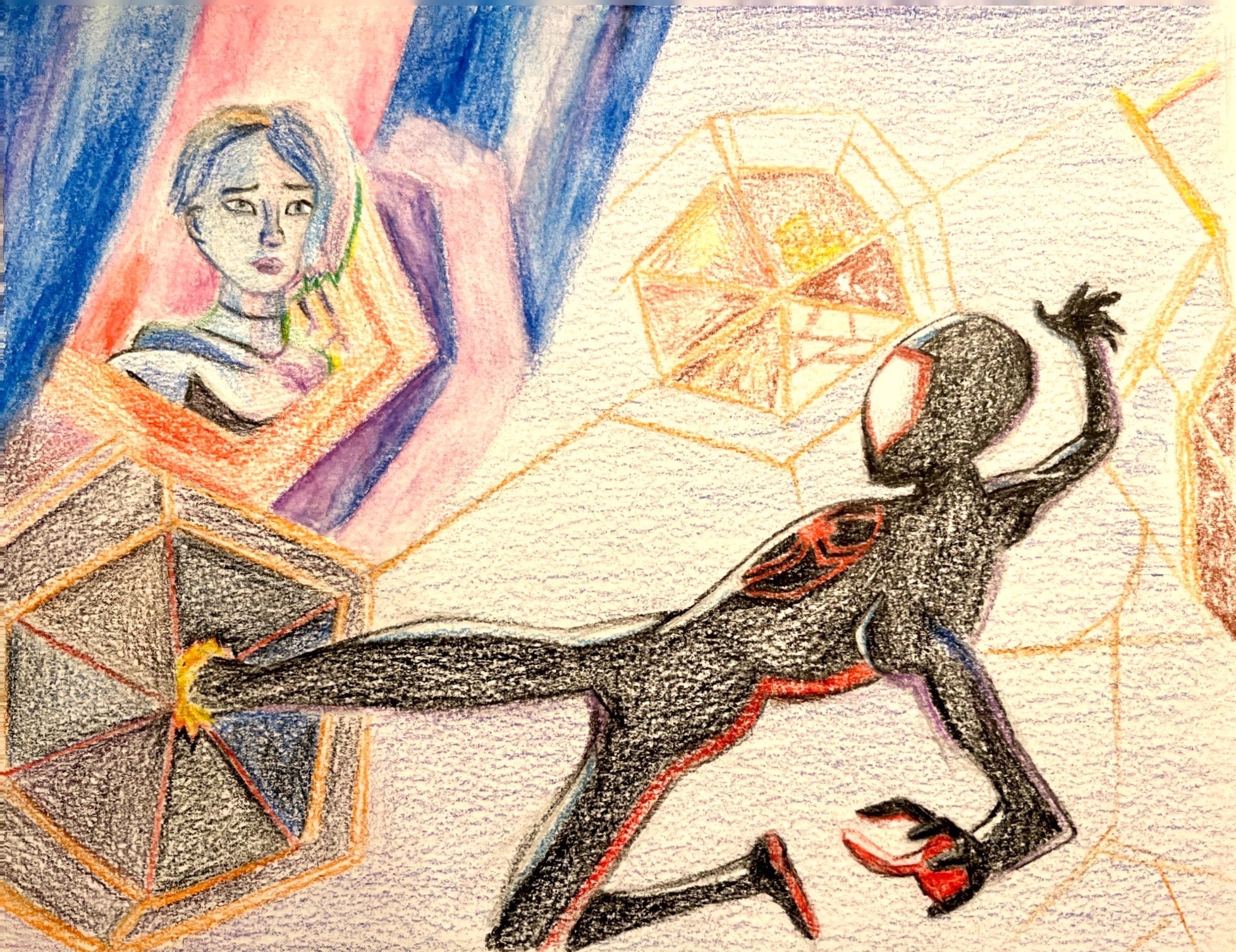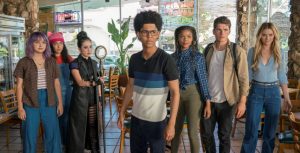“Nah, Imma do my own thing.”
The climactic phrase of Spider-Man: Across the Spider-Verse (2023) embodies the direction the cast and crew took in their creation of the highly-anticipated film. Five years after the release of Spider-Man: Into the Spider-Verse (2018), its sequel has finally hit the theaters, and despite the high standards set by the first installment, part two is just as good, if not better.
Taking place a year after the first film, Across the Spider-Verse follows Miles Morales (Shameik Moore) as he navigates the typical Spider-Man struggles, from balancing his superhero duties with being a top student to hiding his secret identity from his parents. Miles’s problems become more complicated when he is sucked into the Spider-Verse, where he meets other spider personas (both new and old) and finds himself in a fierce disagreement with his counterparts.
Woven into the film’s colorful animation and humor is a deft exploration of the complexities of morality and destiny. As Miles travels through the Spider-Verse, he learns that other Spider-People believe their heroic abilities are limited, acknowledging that sometimes saving everyone is impossible—and sometimes there is no choice but to sacrifice a few for the good of many. Miles is presented with the classic trolley problem: given the choice between saving one person and saving multiple, what is the right thing to do? While the first film considers who can be a hero, Across the Spider-Verse explores just what being a hero means. Miles’s optimistic perception that heroism means doing everything possible to save everyone is challenged by the idea that heroes must operate rationally and strive to minimize costs in a pragmatic manner.
Intertwined with this moral dilemma is an investigation of to what extent people can and should allow external forces to determine their lives. When faced with an impossible challenge, is it better to allow the world to run its course, or to take matters into one’s own hands? The film offers no clear answers to these dilemmas, instead inviting the audience to evaluate the different arguments presented by its characters. And with each Spider-Person believing themself a hero and their ideas stemming from an authentic desire to do good, their conflicting opinions leave them, and the audience, wondering just who the bad guys really are.
The film also offers a skillful portrayal of the intricate relationships and responsibilities between friends and families, showing how love can breed feelings of worry, frustration, and even anger. As Miles struggles to keep more and more secrets from his parents, the dynamic within his family provides an excellent representation of the growing gap between parents and children that accompanies adolescence. Meanwhile, time apart from his friends leaves Miles feeling disconnected from them, and their disagreements only leave him feeling more isolated. While Miles and his friends went their separate ways at the end of the first film, they remained united in friendship and understanding even across dimensions. But as they come together once again, they realize their different experiences and lives foster differing opinions on topics that reach the core of their identity as superheroes— a realization that creates the first cracks in what was previously an unbreakable bond. As the foundations of Miles’ relationships with both his family and friends begin to transform, his journey to make sense of these changes parallels his exploration of his own identity. Forced to ask himself new questions about himself and his values, he learns that sometimes breaking from old ties and forging your own path is necessary to remain true to yourself. While Miles’ problems are presented in a superhero framework, his experiences with those around him are a universal experience. Audiences can connect to Miles’ struggles, leaving them contemplating the film’s themes of ethics, identity, and connection long after the credits have rolled.
In addition to its captivating story and themes, the Spider-Verse series sets itself apart in its masterful animation. While the first film already set a new standard for animation, the art in the sequel somehow manages to best the original. By launching the characters into different dimensions, the creators of the movie experiment with stunning visuals by depicting each character’s world in a different animation style. Additionally, the film expertly uses color to enhance the portrayal of its characters’ emotions and the intensity of climactic moments. Gwen Stacy’s (Hailee Steinfeld) dimension is perhaps the best example of this, with the artists frequently incorporating cool blue tones in contrast with warmer yellow and orange ones to showcase Gwen’s fluctuating moods and conflicting emotions. In a cinematic culture overwhelmed with live-action remakes and animation that strives to be as realistic as possible, the creators of Across the Spider-Verse show all that is possible when the medium of animation is used to its fullest potential. Different art styles, colors, and comic book-like graphics create a movie experience a live-action film could never achieve, proving once again that animated films can provide a stellar movie experience for audiences of all ages.
Topping off the movie is its excellent collection of original music. With a score composed by Daniel Pemberton and an original soundtrack spearheaded by Metro Boomin, the music is the cherry on top of an already excellent film. The soundtrack album highlights Black, African, and Latino artists, including Nas, Myke Towers, Mora, Omah Lay, and many more. The songs are not only perfect additions to anyone’s summer playlist, but they expertly capture the relationships, emotions, and themes explored in the film. Title track “Calling” with Metro Boomin, Swae Lee, Nav, and A Boogie Wit da Hoodie does this particularly well, with a pared-down beat and lyrics exploring conflicting feelings of love, loyalty, guilt, and disconnect, providing the perfect musical representation of the relationship between Miles and Gwen. Worked into the song is a presentation of not just the initial emotions of love and friendship in their relationship, but also the new conflicts they experience. As Miles’s and Gwen’s differing opinions on heroism drive a wedge between them, they find themselves struggling to protect each other without betraying one another, an experience captured with the lyrics “It hurts me when you start to see my flaws / But just to save you, I’d risk it all.”
Lastly, in all aspects of the film, Across the Spider-Verse is the perfect example of meaningful and joyful cultural representation. Too often, stories centering BIPOC characters derive the plot’s conflict from a cultural struggle: a character is resentful of their identity, disconnected from their heritage, or their culture is portrayed as so incompatible with the American landscape that they struggle to make peace with it. While these types of stories are important and highlight the struggles of being BIPOC in the United States, constant portrayals of culture as a source of conflict are exhausting. Across the Spider-Verse provides a fresh representation of culture and race by not establishing them as drivers of conflict, instead masterfully integrating them into all aspects of the film in a celebration of culture. Miles is not just comfortable in his cultural identity, but proud of it—his culture is represented in the food he eats, the languages he speaks, and the way he styles his hair. He is unapologetically Afro-Latino, but the movie’s central conflict is not tied to his racial identity. By acknowledging culture without antagonizing it, the film takes an approach too often overlooked in the media by representing it as a source of joy and pride.
Across the Spider-Verse is a powerful sequel film for all ages, digging deep into questions of morality and trust. And while it took several years to reach cinemas, Across the Spider-Verse’s excellence across all dimensions—from story to art to music—proves it was well worth the wait.




